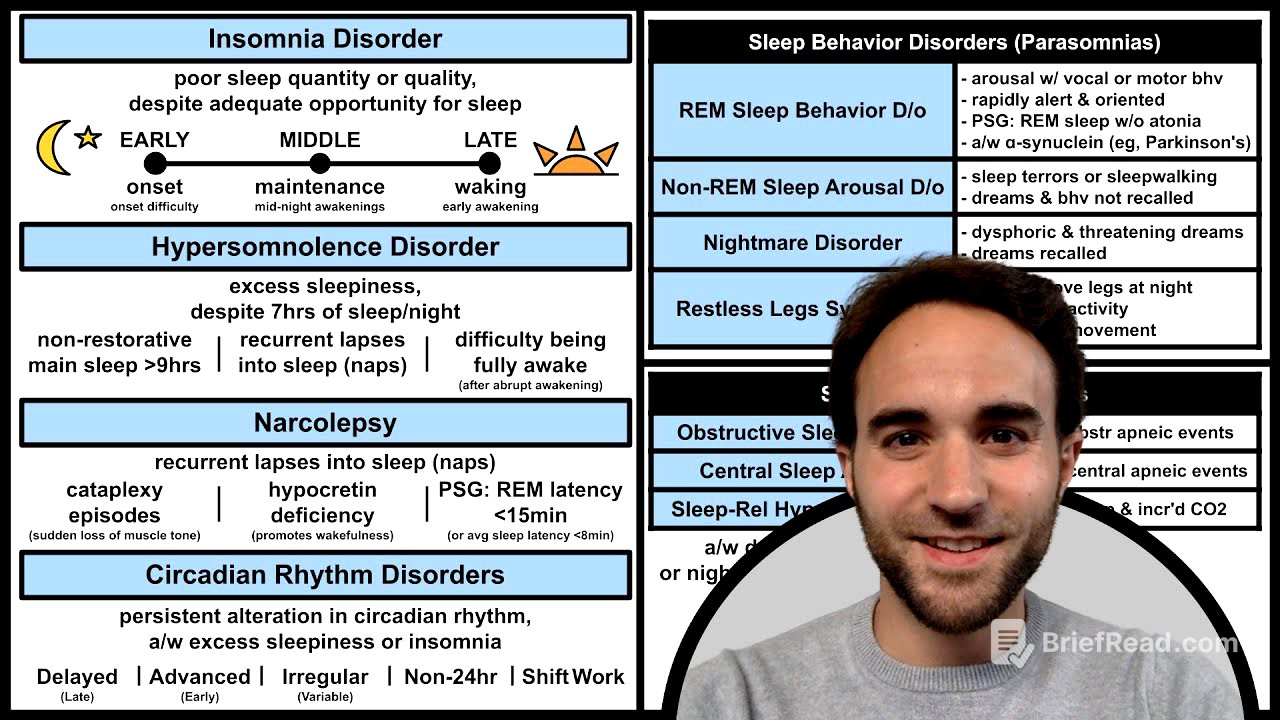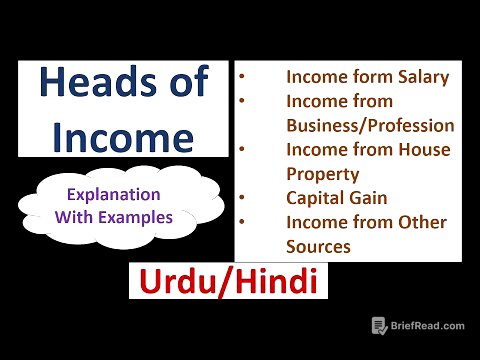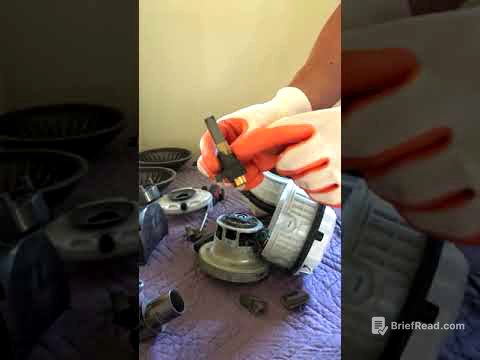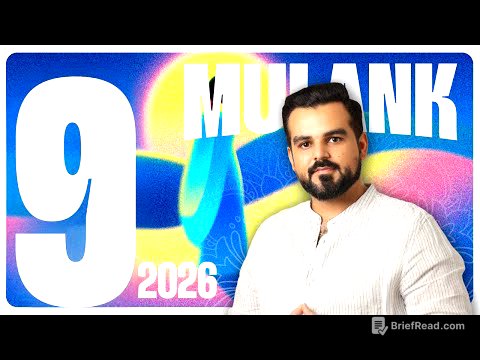TLDR;
This video provides an overview of sleep disorders, focusing on their diagnosis according to the DSM criteria. It covers core sleep disorders like insomnia, hypersomnolence, narcolepsy, and circadian rhythm disorders. Additionally, it addresses sleep behavior disorders (parasomnias) such as REM sleep behavior disorder, non-REM sleep arousal disorder, and restless leg syndrome, as well as sleep breathing disorders including obstructive sleep apnea, central sleep apnea, and sleep-related hypoventilation.
- Insomnia is characterized by poor sleep quality or quantity despite adequate opportunity for sleep, manifesting as early, middle, or late insomnia.
- Narcolepsy involves recurrent lapses into sleep with cataplexy, hypocretin deficiency, or rapid entry into REM sleep.
- Sleep breathing disorders are diagnosed via sleep studies, differentiating between obstructive (physical blockage) and central (brain signal) apneas.
Introduction to Sleep Disorders [0:00]
The talk introduces an overview of sleep disorders, focusing on the diagnostic criteria outlined in the DSM chapter on sleep-wake disorders. Visual aids and mnemonics are used to help remember the criteria for these disorders. The presentation is structured to cover core sleep disorders, sleep behavior disorders, and sleep breathing disorders.
Core Sleep Disorders [0:22]
Insomnia disorder is defined by inadequate sleep quantity or quality despite having enough time and the right environment for sleep. The issues can be categorized based on when they occur during the sleep cycle: early insomnia (difficulty falling asleep), middle insomnia (waking up during the night), and late insomnia (waking up too early). Hypersomnolence disorder involves excessive sleepiness despite getting at least 7 hours of sleep per night, accompanied by symptoms like non-restorative sleep lasting over 9 hours, frequent daytime naps, or difficulty waking up fully. Narcolepsy is characterized by recurrent sleep lapses along with cataplexy (sudden muscle weakness), a deficiency in hypocretin (a neuropeptide promoting wakefulness), or a sleep study showing rapid entry into REM sleep (within 15 minutes). For these disorders, the sleep problem must occur at least three times a week for three months.
Circadian Rhythm Disorders [1:54]
Circadian rhythm disorders involve persistent disruptions in the circadian rhythm and sleep schedule, leading to excessive sleepiness or insomnia. These disorders manifest in several forms: the delayed type (falling asleep and waking up late), the advanced type (falling asleep and waking up early), the irregular type (variable sleep schedule), the non-24-hour type (sleep schedule not following a 24-hour cycle), and the shift work type (sleep schedule adjusted to shift work).
Sleep Behavior Disorders (Parasomnias) [2:35]
REM sleep behavior disorder involves arousals during the night with vocalizations or complex motor behaviors, such as acting out dreams, kicking, thrashing, or shouting. Patients are rapidly alert and oriented when they awaken during these episodes. Pathologically, this disorder involves REM sleep without the usual muscle atonia and is associated with alpha-synuclein diseases like Parkinson's. Non-REM sleep arousal disorder includes sleep terrors, characterized by sudden arousals with intense fear, screaming, and autonomic activation, and sleepwalking, involving elaborate motor behaviors while still asleep. Patients do not recall their dreams or behaviors upon awakening. This contrasts with nightmare disorder, where patients have dysphoric and threatening dreams that they do recall in the morning. Restless leg syndrome involves a recurrent urge to move one's legs, often at night and before sleep, which worsens with inactivity and is relieved by movement.
Sleep Breathing Disorders [3:47]
Sleep breathing disorders are diagnosed based on sleep study results. Obstructive sleep apnea is indicated by at least five obstructive apneic events per hour, where the patient attempts to breathe but is unable to due to respiratory obstruction. Central sleep apnea involves at least five central apneic events per hour, where the patient does not attempt to breathe due to a problem with the brain's respiratory drive stimulation. Sleep-related hypoventilation involves decreased respiration frequency during sleep, leading to increased serum CO2 levels. These disorders are associated with daytime fatigue or nighttime breathing issues like loud snoring, coughing, or choking during sleep.









